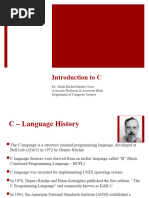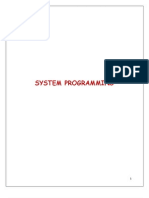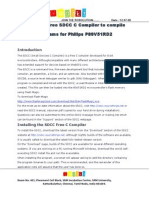C Programming Language History
Uploaded by
Pawan ChandC Programming Language History
Uploaded by
Pawan ChandC Programming Language History
- Dennis Ritchie
What is or is not implemented in the kernel represents
both a great responsibility and a great power. It is a
soap-box platform on 'the way things should be done.'
Even so, if 'the way' is too radical, no one will follow it.
Every important decision was weighed carefully.
Throughout, simplicity has been substituted for
efficiency. Complex algorithms are used only if their
complexity can be localized.
- Ken Thompson; UNIX Implementation; The Bell
System Technical Journal; July - August 1978.
The development of Unix in the C language made it uniquely portable and improvable.
The first version of Unix was written in the low-level PDP-7 assembler language. Soon after,
a language called TMG was created for the PDP-7 by R. M. McClure. Using TMG to develop a
FORTRAN compiler, Ken Thompson instead ended up developing a compiler for a new high-
level language he called B, based on the earlier BCPL language developed by Martin
Richard. Where it might take several pages of detailed PDP-7 assembly code to accomplish
a given task, the same functionality could typically be expressed in a higher level language
like B in just a few lines. B was thereafter used for further development of the Unix system,
which made the work much faster and more convenient.
When the PDP-11 computer arrived at Bell Labs, Dennis Ritchie built on B to create a new
language called C which inherited Thompson's taste for concise syntax, and had a powerful
mix of high-level functionality and the detailed features required to program an operating
system. Most of the components of Unix were eventually rewritten in C, culminating with
the kernel itself in 1973. Because of its convenience and power, C went on to become the
most popular programming language in the world over the next quarter century.
This development of Unix in C had two important consequences:
Portability. It made it much easier to port Unix to newly developed computers,
because it eliminated the need to translate the entire operating system to the new
assemble language by hand:
o First, write a C-to-assembly language compiler for the new machine.
o Then use the new compiler to automatically translate the Unix C language
source code into the new machine's assembly language.
o Finally, write only a small amount of new code where absolutely required by
hardware differences with the new machine.
Improvability. It made Unix easy to customize and improve by any programmer that
could learn the high-level C programming language. Many did learn C, and went on
to experiment with modifications to the operating system, producing many useful
new extensions and enhancements.
You might also like
- History of C Programming Language: CSC 114 Introduction To ProgrammingNo ratings yetHistory of C Programming Language: CSC 114 Introduction To Programming12 pages
- Topic 4 - Introduction To C Programming LanguageNo ratings yetTopic 4 - Introduction To C Programming Language8 pages
- UNIX and Computer Science ACN6-1 - One - ColumnNo ratings yetUNIX and Computer Science ACN6-1 - One - Column75 pages
- Overview of C Language and Environment: Topic No. 03No ratings yetOverview of C Language and Environment: Topic No. 0317 pages
- Computer Programming: Engr. Muhammad Usman Assistant Professor, CSE UET Mardan CampusNo ratings yetComputer Programming: Engr. Muhammad Usman Assistant Professor, CSE UET Mardan Campus43 pages
- GEE 303 Computer Programming: (Lenguaje C)No ratings yetGEE 303 Computer Programming: (Lenguaje C)24 pages
- C Programming Language, A Step By Step Beginner's Guide To Learn C Programming In 7 Days.From EverandC Programming Language, A Step By Step Beginner's Guide To Learn C Programming In 7 Days.3.5/5 (7)
- C Programming: C Programming Language for beginners, teaching you how to learn to code in C fast!From EverandC Programming: C Programming Language for beginners, teaching you how to learn to code in C fast!No ratings yet
- Ecotourism: Tai Phake Khamyang Khampti Singpho Nocte Ahom Nepali Burmese Tea-TribesNo ratings yetEcotourism: Tai Phake Khamyang Khampti Singpho Nocte Ahom Nepali Burmese Tea-Tribes3 pages
- AG Detects Lapses in Implementation of NREGA in UPNo ratings yetAG Detects Lapses in Implementation of NREGA in UP9 pages
- Compile-Time Stack Requirements Analysis With GCC100% (2)Compile-Time Stack Requirements Analysis With GCC13 pages
- A Secure and Scalable System For Online Code Execution and Evaluation Using Containerization and KubernetesNo ratings yetA Secure and Scalable System For Online Code Execution and Evaluation Using Containerization and Kubernetes9 pages
- Topic 1 - Introduction To Programming ConceptsNo ratings yetTopic 1 - Introduction To Programming Concepts23 pages
- Toaz - Info Restaurant Management System Project Report PRNo ratings yetToaz - Info Restaurant Management System Project Report PR27 pages
- Learn Microsoft Visual Basic Net in A Weekend0% (1)Learn Microsoft Visual Basic Net in A Weekend228 pages
- CLASS 6 - Categories of Computers and Computer Languages - CLASS 6No ratings yetCLASS 6 - Categories of Computers and Computer Languages - CLASS 64 pages
- Nehru Smaraka Vidyalaya Bangalore: Investigatory Project in Computer Science TopicNo ratings yetNehru Smaraka Vidyalaya Bangalore: Investigatory Project in Computer Science Topic24 pages
- The University of Faisalabad: School of Electrical EngineeringNo ratings yetThe University of Faisalabad: School of Electrical Engineering3 pages




































































































